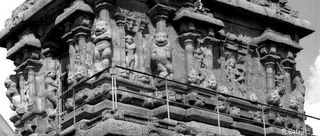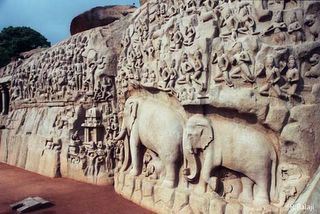Saturday, December 31, 2005
The Olakanathan Temple on a hill top at Mamallapuram. This is a Shiva Temple, and the deity is referred to as the Olakaneeswaran, a reference to the fiery third eye. According to popular legend this temple top acted as a light house, with a fire lit on top, when Mamallapuram was a main port during the Pallava regime over 1,300 years back. 



Sunday, December 25, 2005
Saturday, December 24, 2005
The Mural at Mamallapuram - Arjuna's penance
An extract from the book I' ve already quoted -Mahabalipuram, published by the Archeological Survey of India."This magificent carving is unique in the range of Indian art. Two large boulders with a narrow fissure in between have been chosen to represent a series of rows of gods and goddesses like Chandra (moon), Surya (sun), pairs of Kinnaras and Siddhas, Gandharvas, Apsaras (all of them celestial beings and demigods) etc rushing towards a central point near the cleft where a sage stands on his left foot deeply engaged in penance involving physical mortification. "
..."This scene is generally taken to represent a story from the Mahabarata in which Arjuna, the epic-hero, preformed penance to please Siva and thus to obtain the Pasupata weapon from him."
Apart from this in the cleft can be seen the nagas (snake-like beings) and a range of wild animals including a herd of elephants.
..."This scene is generally taken to represent a story from the Mahabarata in which Arjuna, the epic-hero, preformed penance to please Siva and thus to obtain the Pasupata weapon from him."
Apart from this in the cleft can be seen the nagas (snake-like beings) and a range of wild animals including a herd of elephants.
The high point in Mamallapuram, Arjuna's penance. Here is a full view of the mural, at a guess this must be about 80 ft in width by about 30 ft in height and is considered one of a kind. I took two separate pics and got them stitched digitally (by a professional)- this way the panoramic spread has a better impact I felt. 



This section holds the main characters from which this mural takes its name, Arjuna's penance. The bearded and skeleton-thin character standing on one leg to the right is Arjuna, to his left carrying the trident is the four-armed shiva blessing him. Shiva is surrounded by his `ganas' gods and goddesses. part human and part animal characters, and the more earthly animals and hunters. 



Saturday, December 17, 2005
The elephant in the five ratha complex at Mamallapuram, the monument by the Pallavas. Behind it is the Nakula-Sahadeva ratha. (By mistake I have reversed the order in which I originally planned to post this series of pic. Please scroll down and start from the pic that shows the whole complex for the more detailed caption,) 



Subscribe to:
Comments (Atom)





















